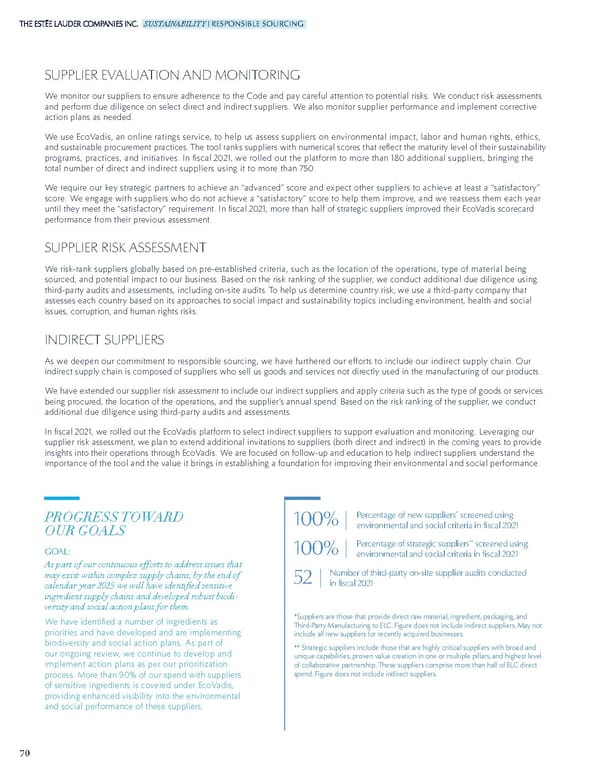70 SUSTAINABILITY RESPONSIBLE SOURCING SUPPLIER RISK ASSESSMENT We risk-rank suppliers globally based on pre-established criteria, such as the location of the operations, type of material being sourced, and potential impact to our business. Based on the risk ranking of the supplier, we conduct additional due diligence using third-party audits and assessments, including on-site audits. To help us determine country risk, we use a third-party company that assesses each country based on its approaches to social impact and sustainability topics including environment, health and social issues, corruption, and human rights risks. SUPPLIER EVALUATION AND MONITORING We monitor our suppliers to ensure adherence to the Code and pay careful attention to potential risks. We conduct risk assessments and perform due diligence on select direct and indirect suppliers. We also monitor supplier performance and implement corrective action plans as needed. We use EcoVadis, an online ratings service, to help us assess suppliers on environmental impact, labor and human rights, ethics, and sustainable procurement practices. The tool ranks suppliers with numerical scores that reflect the maturity level of their sustainability programs, practices, and initiatives. In fiscal 2021, we rolled out the platform to more than 180 additional suppliers, bringing the total number of direct and indirect suppliers using it to more than 750. We require our key strategic partners to achieve an “advanced” score and expect other suppliers to achieve at least a “satisfactory” score. We engage with suppliers who do not achieve a “satisfactory” score to help them improve, and we reassess them each year until they meet the “satisfactory” requirement. In fiscal 2021, more than half of strategic suppliers improved their EcoVadis scorecard performance from their previous assessment. PROGRESS TOWARD OUR GOALS GOAL: As part of our continuous efforts to address issues that may exist within complex supply chains, by the end of calendar year 2025 we will have identified sensitive ingredient supply chains and developed robust biodi - versity and social action plans for them. We have identified a number of ingredients as priorities and have developed and are implementing biodiversity and social action plans. As part of our ongoing review, we continue to develop and implement action plans as per our prioritization process. More than 90% of our spend with suppliers of sensitive ingredients is covered under EcoVadis, providing enhanced visibility into the environmental and social performance of these suppliers. INDIRECT SUPPLIERS As we deepen our commitment to responsible sourcing, we have furthered our efforts to include our indirect supply chain. Our indirect supply chain is composed of suppliers who sell us goods and services not directly used in the manufacturing of our products. We have extended our supplier risk assessment to include our indirect suppliers and apply criteria such as the type of goods or services being procured, the location of the operations, and the supplier’s annual spend. Based on the risk ranking of the supplier, we conduct additional due diligence using third-party audits and assessments. In fiscal 2021, we rolled out the EcoVadis platform to select indirect suppliers to support evaluation and monitoring. Leveraging our supplier risk assessment, we plan to extend additional invitations to suppliers (both direct and indirect) in the coming years to provide insights into their operations through EcoVadis. We are focused on follow-up and education to help indirect suppliers understand the importance of the tool and the value it brings in establishing a foundation for improving their environmental and social performance. 100% 100% 52 *Suppliers are those that provide direct raw material, ingredient, packaging, and Third-Party Manufacturing to ELC. Figure does not include indirect suppliers. May not include all new suppliers for recently acquired businesses. ** Strategic suppliers include those that are highly critical suppliers with broad and unique capabilities, proven value creation in one or multiple pillars, and highest level of collaborative partnership. These suppliers comprise more than half of ELC direct spend. Figure does not include indirect suppliers. Percentage of new suppliers * screened using environmental and social criteria in fiscal 2021 Percentage of strategic suppliers ** screened using environmental and social criteria in fiscal 2021 Number of third-party on-site supplier audits conducted in fiscal 2021
 Estee Lauder Companies Sustainability Report Page 70 Page 72
Estee Lauder Companies Sustainability Report Page 70 Page 72